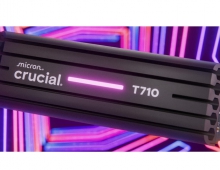Crucial m4 256GB SSD Review
2. Package, installation
Review Pages
Package
We received the 256GB Crucial m4 SSD 2.5" with Data Transfer Kit (Part #: CT256M4SSD2CCA) version of the drive, which a USB to SATA cable, making it it simple to copy everything on your hard drive, including operating system, data, email settings and applications, to the Crucial m4. The kit includes the EZ Gig III Cloning and Imaging Software for Windows, ShirtPocket's SuperDuper! for Mac and a Quick Start Guide.
The specific package retails online for US $489.99. Crucial's other versions of the m4 256GB SSD will cost you a little bit less: $470 for the basic drive without any software (Part #: CT256M4SSD2), and $475 for the 256GB
256GB Crucial m4 SSD 2.5" version with a 3,5" bracket ( Part #: CT256M4SSD2BAA).
Below you see the package of the 2.5" Crucial M4 256GB SSD.




The drive uses a SATA III interface, which offers a maximum data rate of 6Gbps. Although it is backwards compatible with SATA II (GBps) the drive will show its strength in the faster interface.
The drive measures 9.5 x 69.85 x 100.5mm, weighs 75g, uses 280mW in use and 100mW idle with a MTBF statistic of 1.2 million hours and it is backed with a 3-Year warranty.

Disassembly
The 256GB Crucial m4 SSD 2.5" SSD is using Intel's 25nm MLC NAND and the Marvell SATA 6Gb/s controller. With Micron's close partnership with Marvell, they are able to get access to controller variations not offered to other companies. The new m4 is powered by the 88SS9174-BLD2 processor, which is an update to the BJP2 model found in the older C300.
The 256GB model includes sixteen 16GB Micron 29F128G08CFAAB NAND pieces, split up with eight soldered to each side of the circuit board.
Installation
The SSD can be easily installed in your chassis. The procedure is no different than installing any other drive. Connect the SATA and power cable, and you are good to go.
The installed SSD was identified as "M4-CT256M4SSD2" with firmware v0.001.
After installation, Intel's software in our test PC provided some information about the drive. As you see in the screen shot below, the drive is offering 244,198MB of storage, which is higher than what we get from other SSDs of the category, which are typically available in 240GB configurations.

More information about the drive is provided by the CrystalDiskInfo utility:

For better performance under Windows Vista, you may need to disable any HDD optimizations such as drive indexing, prefetch superfetch disabled and defragmentation.
Windows 7 and Windows Server 2008 R2 support the TRIM function, which the operating systems use when they detect that a file is being deleted from an SSD. Here is how it works: When the OS deletes a file on an SSD, it updates the file system but also tells the SSD via the TRIM command which pages should be deleted. At the time of the delete, the SSD can read the block into memory, erase the block, and write back only pages with data in them. This will result in no performance degradation for writes because the pages are already empty. As you realize TRIM only improves performance when you delete files and not when you overwrite an existing file.
You may also consider enabling the AHCI mode, which could give your SSD a little extra performance boost.
Review Pages





















